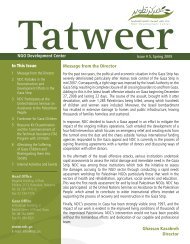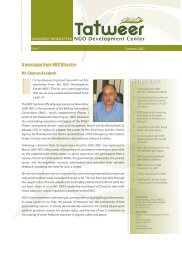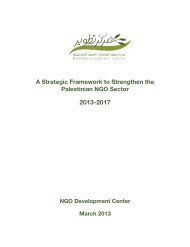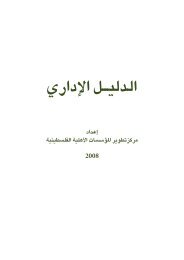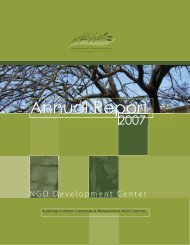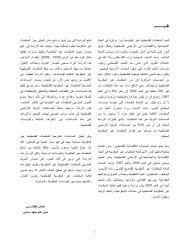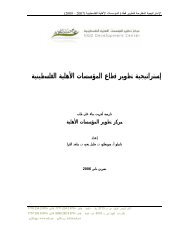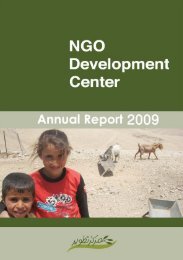Tracking External Donor Funding.pdf - NDC
Tracking External Donor Funding.pdf - NDC
Tracking External Donor Funding.pdf - NDC
Create successful ePaper yourself
Turn your PDF publications into a flip-book with our unique Google optimized e-Paper software.
institutions, we looked to the annual diaries of PASSIA<br />
and its listing of approximately 120 to 130 international<br />
organizations and donors according to the locations of<br />
their HQs and Field Offices.<br />
World Bank and OECD data is referenced throughout the<br />
study or offered as a comparison, and the PCBS was<br />
used for most demographic statistics.<br />
1.4.3 Survey Limitations<br />
Our research aimed to track the trends in external<br />
funding to PNGOs over a ten year period. In doing so,<br />
we faced a number of obstacles and difficulties.<br />
Data Availability of <strong>Donor</strong>s and PNGOs<br />
During our primary data collection, we found that many<br />
local and international organizations, especially the<br />
smaller ones, lacked proper data concerning the sector,<br />
geography and target populations of their work over<br />
time, typically for one of the following reasons:<br />
<br />
<br />
<br />
They do not keep such data, or have only recently<br />
begun to do so<br />
Publicly available data is most often given in broad<br />
aggregate programs in annual financial and activities<br />
reports.<br />
In the case of donors, existing data was sometimes<br />
not available in either English or Arabic, rather only<br />
the language of the donor country.<br />
Institutional Knowledge of <strong>Donor</strong>s and PNGOs<br />
Often the lack of data required researchers to depend<br />
heavily upon the staff and their memories to provide<br />
educated estimates during our primary data collection. In<br />
doing so, our fieldworkers found that the level of<br />
experience in many NGO offices was noticeably low. In<br />
many cases, the majority of the staff had been working<br />
for the same organization for a short time; and in a few<br />
instances, the same was true of the management.<br />
Transparency, Participation and Bias<br />
There was a palpable, if not widespread, sense of<br />
mistrust amongst a number of donors and PNGO<br />
institutions we approached for primary data. A small<br />
number of organizations refused outright to take part in<br />
the survey, while a larger proportion agreed initially, but<br />
then refused to release the data within the time limit.<br />
<br />
<br />
<br />
Organizations’ fears of being associated with<br />
agencies that carry a political stigma, such as<br />
USAID.<br />
The previous 'turf war' between the PA and NGO<br />
sector (culminating in the late 1990's attempts by the<br />
PA to levy greater regulations on civil society) left<br />
many NGOs mistrustful of attempts to gather<br />
information.<br />
The current state of division between Hamas/Fatah<br />
and the West Bank/Gaza Strip has created an<br />
atmosphere in which openness and transparency is<br />
not encouraged. This was more evident for<br />
fieldworkers in the Gaza Strip.<br />
From the organizations who did return data, there was<br />
the additional danger of accuracy and credibility. We<br />
believe that it is possible for respondents to have painted<br />
an idealized picture of the organization's activities, rather<br />
than a real one.<br />
Terminology and Allocation<br />
The detailed information required to fill out this survey,<br />
in terms of sectors, geographic distribution and even<br />
target populations served, is largely unavailable on the<br />
websites of PNGOs or their donors, making secondary<br />
data collection difficult. This is also true of Annual or<br />
Financial Reports - the former providing only summaries<br />
or ‘success stories’ of their work, and the latter giving<br />
numbers in aggregates that are not useful. When data is<br />
actually available on a project by project basis, a major<br />
disadvantage for researchers is the use of project titles in<br />
deciphering sectors or target groups. Yet this is often the<br />
most one can find. Project titles are sometimes sculpted<br />
in a manner that market their proposals rather than<br />
describe them.<br />
If a ‘good’ project title for the purpose of this research<br />
and the understanding of external aid were to look like<br />
this: Drama Therapy for Refugee Youth in Jenin. A<br />
‘marketed’ project title would look something like:<br />
Reversing the Culture of Pain. A ‘fashionable’ title<br />
adopting the international jargon would be more like:<br />
Empowering Refugee Youth through Sustainable,<br />
Cultural Interventions 5 . The risk of ambiguous project<br />
titles for researchers is the possible misallocation of aid<br />
to a particular sector or target group during the secondary<br />
data collection.<br />
In either of these cases, the most likely cause for not<br />
participating was the lack of available manpower to fill<br />
our lengthy survey. However, on several occasions,<br />
donors or PNGOs cited an unwillingness to disclose the<br />
data. We believe that the reasons unwillingness to share<br />
data revolves around:<br />
5<br />
These examples come from one of the authors’ experiences in<br />
fundraising. Each of these titles was used for the same project<br />
proposal but then sent to different donors.<br />
6


